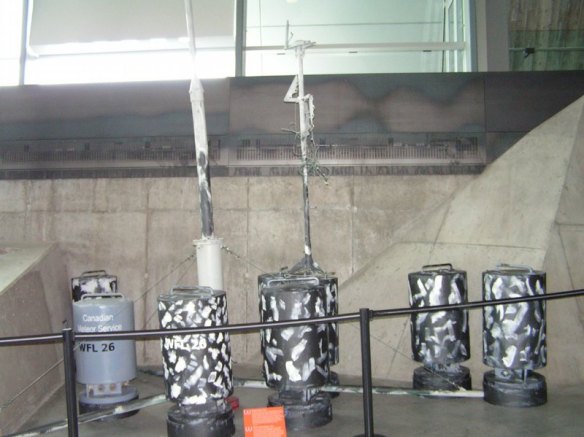Weather Station Kurt on display at the Canadian War Museum
Weather Station Kurt (Wetter-Funkgerät Land-26) was a automatic weather station, erected by a German U-boat crew in Northern Labrador, Newfoundland in October 1943. Installing the equipment for the station was the only known armed German military operation on land in North America during the Second World War.
The Germans developed the Wetter-Funkgerät Land weather station. It was designed by Dr. Ernest Ploetze and Edwin Stoebe. Twenty-six were manufactured by Siemens. The WFL had an array of measuring instruments, a telemetry system and a 150 watt, Lorenz 150 FK-type transmitter. It had 10 cylindrical canisters, each 1 metre (3.3 ft) by c.47 cm diameter (1.5 metres (4.9 ft) circumference) and weighing around 100 kilograms (220 lb). One canister contained the instruments; it was attached to a 10-metre (33 ft) antenna mast. A second, shorter mast carried an anemometer and wind vane. The other canisters contained nickel-cadmium batteries that powered the system. The WFL would broadcast weather readings every three hours during a two minute transmission on 3940 kHz. The system could work for up to six months, depending on the number of battery canisters.
Fourteen stations were deployed in Arctic and sub-Arctic regions (Greenland, Bear Island, Spitsbergen and Franz Josef Land) and five were placed around the Barents Sea. Two were intended for North America. One was deployed in 1943 by the U-boat U-537, but the submarine carrying the other, U-867, was sunk.
On September 18, 1943, U-537, commanded by Kapitänleutnant Peter Schrewe, departed from Kiel, Germany on her first combat patrol. It carried WFL-26, codenamed “Kurt”, a meteorologist, Dr Kurt Sommermeyer, and his assistant, Walter Hildebrant. En route, the U-boat was caught in a storm and a large breaker produced significant damage, including leaks in the hull and the loss of the submarine’s quadruple anti-aircraft cannon, leaving it both unable to dive and defenseless against Allied aircraft.
On October 22, the U-537 arrived at Martin Bay in Northern Labrador, at a position 60°5′0.2″N 64°22′50.8″WCoordinates: 60°5′0.2″N 64°22′50.8″W. This is close to Cape Chidley at the north-eastern tip of the Labrador Peninsula. Schrewe selected a site this far north as he believed this would minimize the risk of the station being discovered by Inuit people. Within an hour of dropping anchor a scouting party had located a suitable site and soon after Dr. Sommermeyer, his assistant and ten sailors disembarked to install the station. Armed lookouts were posted on nearby high ground and other crew set to repair the submarine’s storm damage.
For concealment, the station was camouflaged. Empty American cigarette packets were left around the site to deceive any Allied personnel that chanced upon it, and the equipment was marked as the property of the non-existent “Canadian Meteor Service” (although, at the time, the area was part of the Dominion of Newfoundland, not part of Canada). The crew worked through the night to install Kurt and repair their U-boat. They finished just 28 hours after dropping anchor and, after confirming the station was working, U-537 departed. It undertook a combat patrol in the area of the Grand Banks of Newfoundland during which it survived three attacks by Canadian aircraft, but sank no ships. The submarine reached port at Lorient, France on December 8, after 70 days at sea
The last and most successful of Germanís secret Arctic weather stations during World War II, Operation Haudegen was under the command of Wilhelm Dege, a geographer fluent in Norwegian and long familiar with the area. After arriving in mid- September 1944, he and his trained team of 11 men-equipped with provisions for 18 months-set up the facility in a remote fjord on Nordaustlandet, the northernmost island in Svalbard (Spitsbergen). Deemed essential for timely weather forecasting for military operations in northern and central Europe, the meteorological data was recorded at intervals of several hours and conveyed to Berlin via radio. Hydrogen-filled radiosonde balloons were sent aloft every afternoon to measure conditions in the lower levels of the stratosphere. Besides submitting these reports, the group pursued scientific research related to Polar Regions in general.
Unlike many earlier manned Arctic stations-Nussbaum, Holzauge, Bassgeiger, and Edelweiss I and II-Haudegen escaped detection by Allied forces and continued to function until the end of the war. Not only did the Norwegian rescue ship need specific instructions regarding the weather station’s location, but Dege’s group had the distinction of being the last German military unit to surrender, nearly four months after the cessation of hostilities. His detailed account of the yearlong endeavor, Wettertrupp Haudegen (War North of 80), appeared in 1954.
